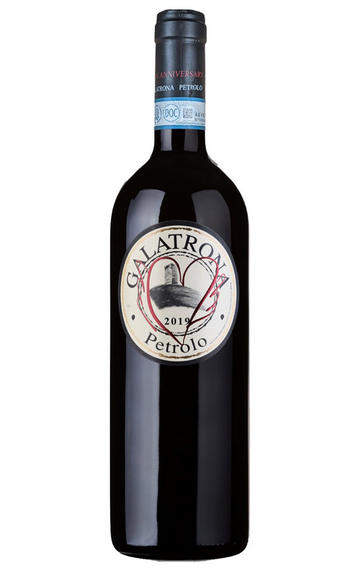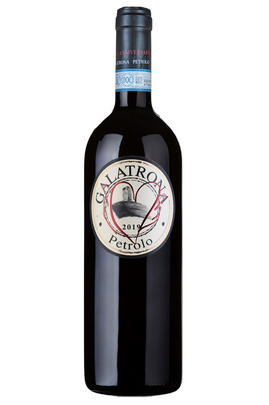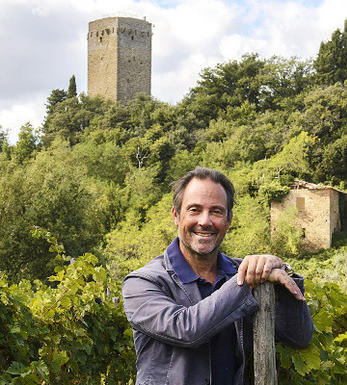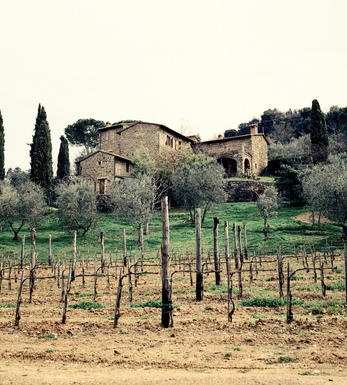
2019 Galatrona, Val d’Arno di Sopra, Petrolo, Tuscany, Italy

Critics reviews
The 2019 Galatrona is a gorgeous wine. It possesses striking depth, but with the freshness and delineation that is a signature these days. Blue/purple fruit, mocha, incense, espresso and lavender build in this potent, pure Merlot from the hills. The 2019 is one of the better recent vintages I can remember tasting.
Luca Sanjust turned out a gorgeous set of wines at Petrolo. This year, I especially like the Sangiovese Boggina, which is one of the best wines I have ever tasted here. The flagship Merlot Galatrona is not too far behind. There is a feeling of purity in the wines today that it so appealing. The only wine I did not find compelling is the Trebbiano, which is totally dominated by heavy reductive notes.
Drink 2025 - 2039
Antonio Galloni, Vinous.com (July 2022)
The 20 year anniversary vintage of Luca Sanjust’s 10ha estate set at 300m of altitude in the southern part of Tuscany by the Chianti hills, showcasing the power of its clay soils. Heavy smoke on the opening, violet edging, plenty of light and shade to the ripe Merlot fruits, with a rough grain to the tannins that adds a seductive contrast to luscious raspberry and blackberry coulis. Softens on the finish but there is plenty of freshly cut rosemary, with the freshness of the Chianti hills.
Drink 2023 - 2034
Jane Anson, Inside Bordeaux (October 2021)
Made with organic Merlot grapes, the Petrolo 2019 Galatrona is soft and luscious, spreading evenly over the palate with elegance and sweeping intensity. The bouquet shows dark fruit, black cherry and sweet prune. Those dark fruit tones are woven into pretty layers of spice, leather and perfumed tobacco. I like the tight, compact, yet fundamentally rich quality that is part of the mouthfeel in this important vintage. This wine could be considered a bit lighter and more ethereal compared to recent past releases, but I found that all the wines in this batch of new releases go in this same direction.
Drink 2023 - 2045
Monica Larner, Wine Advocate (March 2022)
Fleshy and chewy with lots of tannic fur on the palate. Far too tight and grainy to drink now, with the structure overwhelming the relatively restrained black fruit.
Drink 2025 - 2040
Richard Hemming MW, JancisRobinson.com (August 2022)
Blackberries and black cherries with lavender and violets on the nose. Full-bodied with velvety, chewy tannins, yet the fruit is very intense with vibrancy and energy. Muscular, yet agile. Pure and poised. A unique definition of merlot in Tuscany.
Drink after 2025
James Suckling, JamesSuckling.com (August 2021)
The 25th-anniversary bottling of this 100% Merlot wine and jewel in the collection of owner-winemaker Luca Sanjust’s 10-hectare Fattoria di Petrolo estate, located just outside the Chianti Classico zone near Montevarchi. This has a wonderful floral touch to the aromas, beguiling and elegant, with a touch of wild strawberries. Satin-like at first, then the textured tannins settle surrounded by succulent cherry, raspberry and blackberry fruit finishing with a herbal lift at the end. Excellent drive, smooth and satisfying with a long life ahead.
Drink 2022 - 2045
Georgina Hindle, Decanter.com (July 2021)
About this WINE

Fattoria Petrolo Galatrona
Petrolo are based in the Val d’Arno in northern Tuscany and since the 1980s have produced a range of wines from Sangiovese, Cabernet Sauvignon, Merlot, Malvasia and Trebbiano Toscano, but it’s with Merlot that they have found most success. This is an historic wine growing area and can trace its history back to the early 18th century, while French grape varieties have been used alongside the native Sangiovese here since the early 19th century. In the 1940s, the Petrolo estate was bought by the Bazocchi family and is now owned by Luca Sanjust, a former painter.
Petrolo’s vineyards extend across 31ha of which 26ha are in production. With an altitude between 250 and 450 meters above sea level, the vineyards grow over moderately loose-packed soil with rocky stratifications of limestone, sand, claystone and flakes of shale typical of the Chianti area.
The Galatrona vineyard extends for just 3ha and was planted in 1990. Galatrona is the first Merlot vineyard that Petrolo planted. The wine is named after the medieval tower that overlooks the Petrolo estate. It was first produced in 1994, when a late picked parcel of Merlot was kept separate and bottled as a single varietal.

IGT Tuscany
IGT (Indicazione Geografica Tipica) Tuscany is a wine classification from Italy's Tuscany region. It is one of the official wine classifications recognized by the Italian government. IGT is a step below the highest classification, DOCG (Denominazione di Origine Controllata e Garantita), and above the DOC (Denominazione di Origine Controllata) level.
The IGT classification was introduced in 1992 to allow winemakers more flexibility in grape varieties and employ winemaking techniques while still ensuring a certain level of quality and geographical indication. This classification gives winemakers more freedom to experiment and innovate, deviating from the strict regulations of the DOC and DOCG classifications.
IGT Tuscany wines can be produced throughout the entire region of Tuscany, encompassing various sub-regions and terroirs within the area. This classification allows winemakers to use traditional Tuscan grape varieties, such as Sangiovese, and non-traditional grape varieties, including international ones like Cabernet Sauvignon, Merlot, Syrah, and others.
The IGT Tuscany classification gives winemakers the flexibility to create wines that showcase the unique characteristics of their specific vineyards and winemaking styles. It allows for experimentation with blending different grape varieties, using innovative winemaking techniques, and exploring new regional vineyard sites.
IGT Tuscany wines can vary greatly, from traditional and terroir-driven expressions to more modern and international styles. This classification has played a significant role in developing Super Tuscan wines, often IGT designated and known for their high quality and international recognition.
Overall, IGT Tuscany provides a platform for winemakers in the region to express their creativity and produce wines that reflect their unique vision while maintaining a connection to the rich heritage and traditions of winemaking in Tuscany.

Merlot
The most widely planted grape in Bordeaux and a grape that has been on a relentless expansion drive throughout the world in the last decade. Merlot is adaptable to most soils and is relatively simple to cultivate. It is a vigorous naturally high yielding grape that requires savage pruning - over-cropped Merlot-based wines are dilute and bland. It is also vital to pick at optimum ripeness as Merlot can quickly lose its varietal characteristics if harvested overripe.
In St.Emilion and Pomerol it withstands the moist clay rich soils far better than Cabernet grapes, and at it best produces opulently rich, plummy clarets with succulent fruitcake-like nuances. Le Pin, Pétrus and Clinet are examples of hedonistically rich Merlot wines at their very best. It also plays a key supporting role in filling out the middle palate of the Cabernet-dominated wines of the Médoc and Graves.
Merlot is now grown in virtually all wine growing countries and is particularly successful in California, Chile and Northern Italy.


Buying options
Add to wishlist
Description
Made with organic Merlot grapes, the Petrolo 2019 Galatrona is soft and luscious, spreading evenly over the palate with elegance and sweeping intensity. The bouquet shows dark fruit, black cherry and sweet prune. Those dark fruit tones are woven into pretty layers of spice, leather and perfumed tobacco. I like the tight, compact, yet fundamentally rich quality that is part of the mouthfeel in this important vintage. This wine could be considered a bit lighter and more ethereal compared to recent past releases, but I found that all the wines in this batch of new releases go in this same direction.
Drink 2023 - 2045
Monica Larner, Wine Advocate (March 2022)
wine at a glance
Delivery and quality guarantee